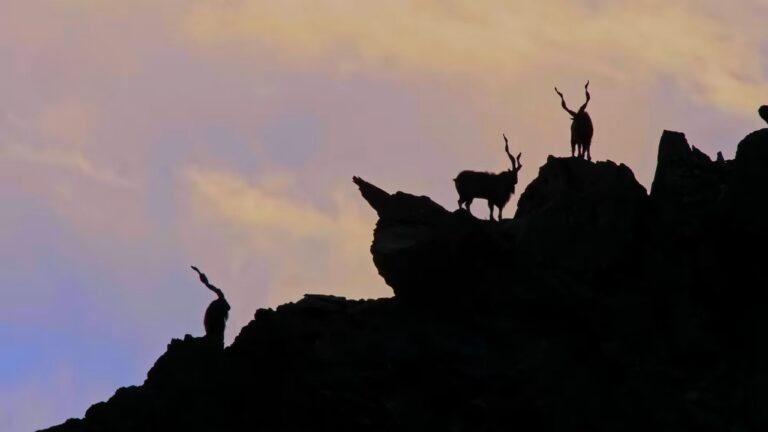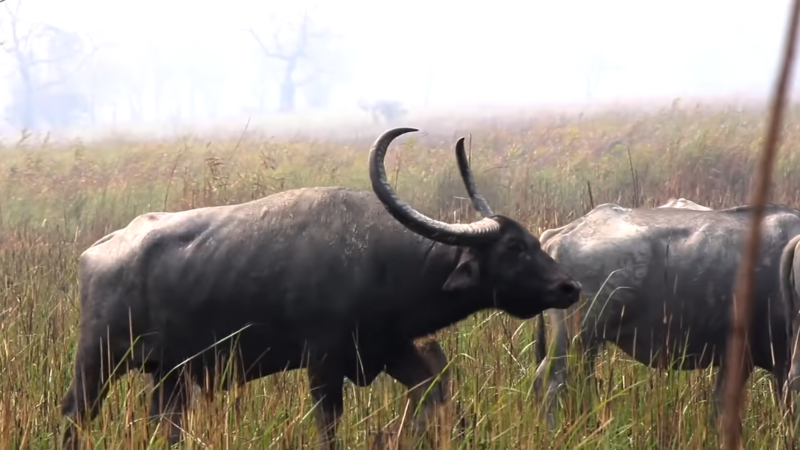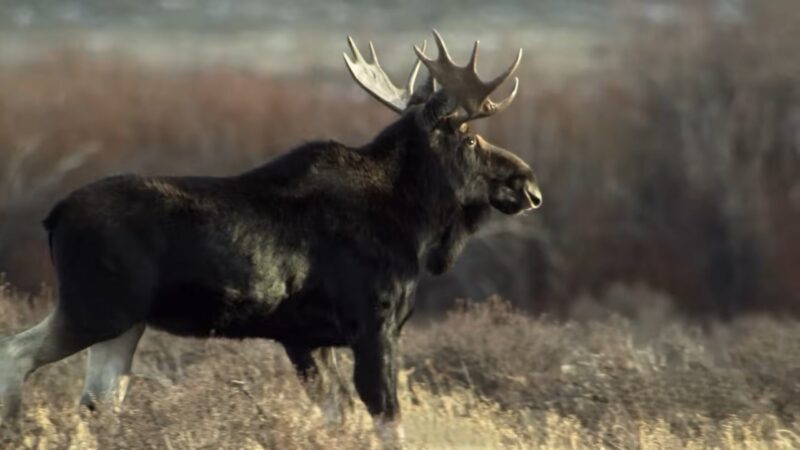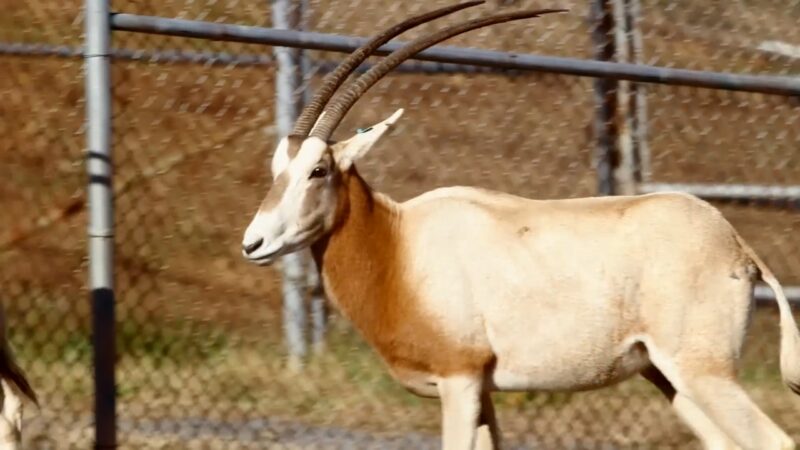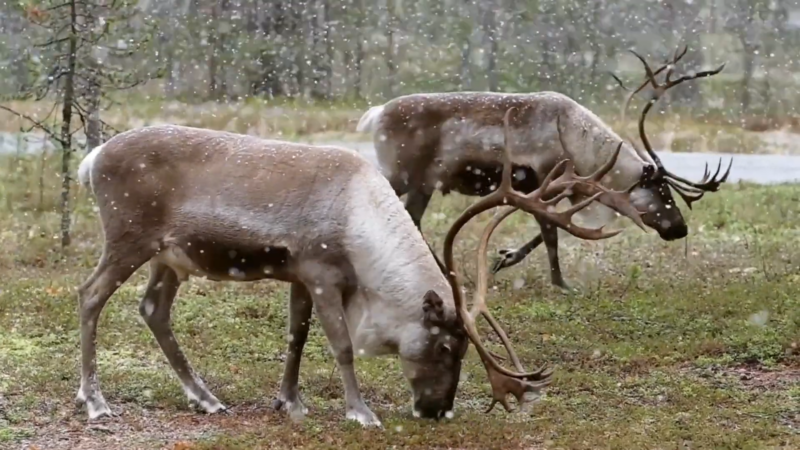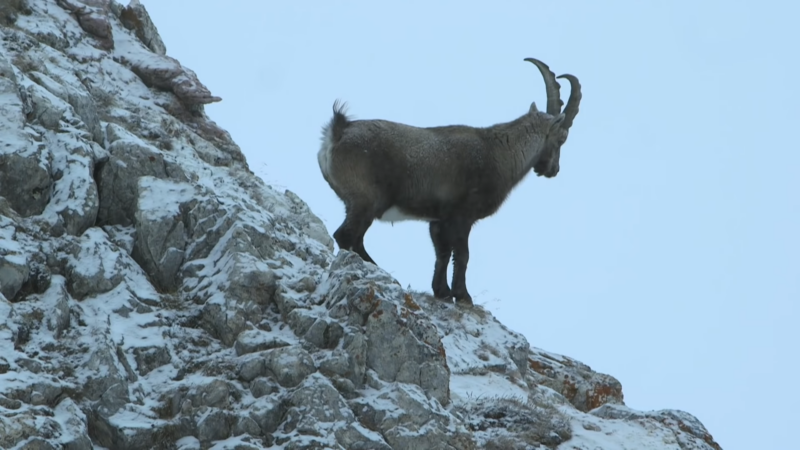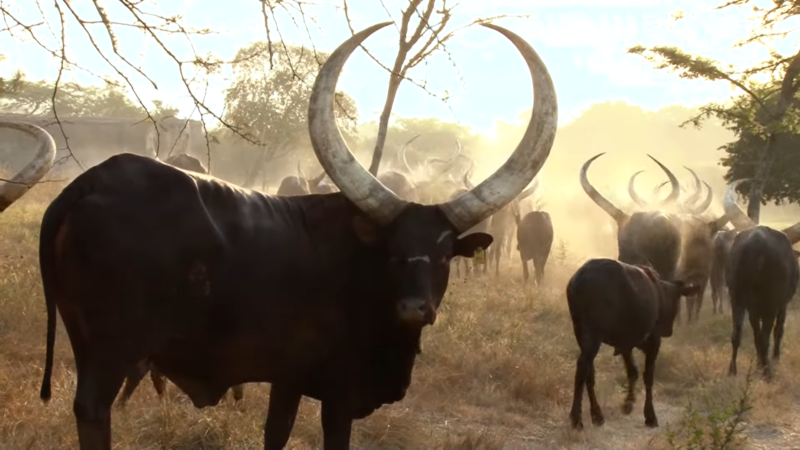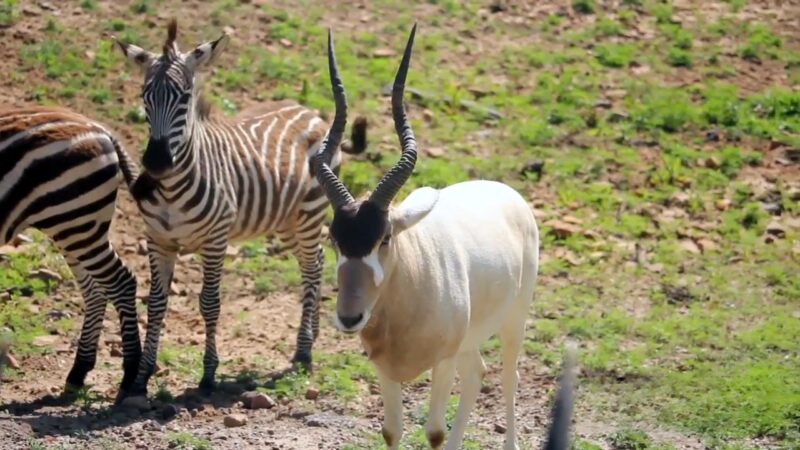Horns are one of the most visible and impressive adaptations developed by some mammals in the animal kingdom.
Lots of animals grow horns, including cows, goats, buffalo, antelope, rhinos, and deer. Animals use their horns for different reasons.
Some use their horns to protect themselves from predators, while others use them to fight members of their own species.
Outside of attack and defense, animals may use horns to dig for food in the soil or peel bark off trees.
They may also feature in mating displays, and the blood vessels inside horns help to maintain the animal’s body temperature.
In most species, only males grow horns, but in a few select species, the females also grow horns. Horns come in all shapes and sizes, from small and straight to long and twisted.
So, which creatures rank among the animals with the biggest horns in the world?
For our measurements, we’ll consider horn length, as well as horn spread and weight. That said, horn length and spread will be the primary factors for our determination.
So crack out your tape measures, because we’re about to discover 10 animals with the biggest horns in the world.
1. Asian Water Buffalo
These majestic creatures, also known as water buffalo, originally hailed from India and Southeast Asia. Nowadays, they’re pretty much global celebrities with over 130 million of them roaming around the world. There are two main types: the river buffalo, which is taller and leaner, and the swamp buffalo, which is more on the stocky side.
| Feature | River Buffalo | Swamp Buffalo |
|---|---|---|
| Height | 47-63 inches | 47-63 inches |
| Weight | 660-2,400 pounds | 660-2,400 pounds |
| Skin Color | Black, Blue, Gray | Black, Blue, Gray |
| Horn Length | Up to 10 feet | Up to 10 feet |
Their skin color can range from black to blue to gray, depending on their age and subspecies. They stand between 47 to 63 inches tall and can weigh anywhere from a petite 660 pounds to a hefty 2,400 pounds.
Now, about those famous horns: most water buffalo sport horns that spread outwards and curve into a graceful semicircle, typically reaching up to 10 feet from point to point. But the world record-holder, a legendary bull shot in 1955, had horns that spanned an astonishing 13 feet, 10 inches. Talk about making a point!
2. Moose
Moose can be found strutting their stuff across North America and parts of Poland, Kazakhstan, and Russia, where they’re known as elk. Unlike their social deer cousins, moose are the lone wolves of the family. They prefer to hang out solo, only getting together for a bit of romance during the breeding season.
| Feature | Description |
|---|---|
| Height | 4.6 to 6.9 feet |
| Weight | 441 to 1,543 pounds |
| Antler Size | Up to 83 inches from point to point |
| Antler Weight | Up to 40 pounds each |
Standing tall at 4.6 to 6.9 feet and weighing between 441 and 1,543 pounds, these giants are not to be messed with. But it’s the males who truly steal the show with their antlers. These magnificent antlers grow in a dendritic, or twig-like pattern, branching out from the center of their heads, curving upwards, and broadening out.
A mature bull moose’s antlers can stretch up to a whopping 83 inches from point to point.
During the breeding season, things get even more dramatic. Male moose use their hefty antlers to wrestle with each other for the affection of the ladies. It’s like the ultimate moose martial arts tournament!
3. Scimitar Oryx
The scimitar oryx is one of four oryx species found throughout Africa. Sadly, they went extinct in the wild around the year 2000. But don’t lose hope! These magnificent animals still live in closely monitored preserves and zoos around the globe.
| Feature | Description |
|---|---|
| Height | Up to 3.3 feet |
| Horn Length | Up to 47 inches |
| Coat Color | Mostly white or beige |
| Distinguishing Features | Lack of dark face and leg markings, curved horns |
Unlike their oryx cousins, scimitar oryxes stand out with their lack of dark face and leg markings. Instead, they sport a mostly white or beige coat, which is perfect for staying cool under the scorching desert sun. They stand up to 3.3 feet tall, with males being slightly larger than females.
Both males and females grow those signature horns, which can reach up to 47 inches in length. While they’re technically classified as straight-horned antelopes, their dramatically curved horns are their claim to fame. It’s this distinctive curve that makes their horns look like scimitars, hence the name.
4. Caribou
Caribou are found roaming across North America, northern Europe, and Siberia. However, some populations are listed as Threatened by the IUCN, so these majestic creatures need our attention and care. Caribou typically live in herds, and while some are the nomadic type, others prefer to stay put all year long.
| Feature | Description |
|---|---|
| Habitat | North America, Northern Europe, Siberia |
| Coat Color | Gray-brown with a thick mane around the neck |
| Herd Behavior | Some migrate, others stay year-round |
| Antler Length | Up to 39 inches point to point, 53 inches long |
| Antler Growth | Both males and females grow antlers |
Caribou sport a gray-brown coat with a thick, luxurious mane around their necks. The size of caribou can vary depending on the subspecies, with the boreal woodland caribou usually being the largest.
Now, let’s talk antlers. Both male and female caribou grow these impressive headpieces, though their size and presence can vary by subspecies. During the growth phase, their antlers are covered in a thick velvet that eventually sheds once the antlers stop growing.
These antlers can reach up to 39 inches from point to point and measure 53 inches long, making them the largest antlers compared to body size of any deer species.
5. Greater Kudu
Greater kudus roam the wilds of Eastern and Southern Africa, though some populations are threatened by habitat loss and poaching. These elegant antelopes are known for their slender bodies and long legs, making them look like the supermodels of the antelope world.
| Feature | Description |
|---|---|
| Habitat | Eastern and Southern Africa |
| Coat Color | Brownish-gray or reddish-brown with 4 to 12 white stripes |
| Height | Up to 63 inches |
| Weight | 420 to 694 pounds |
| Horn Length | 47 to 74 inches along the curve |
| Distinguishing Features | Beards and twisted horns with 2 to 3 twists |
The greater kudu sports a coat that ranges from brownish-gray to reddish-brown, adorned with 4 to 12 striking white stripes across their torso. These stripes not only make them look stylish but also help them blend into their surroundings.
Males are quite the giants, standing up to 63 inches tall and weighing between 420 to 694 pounds. Apart from their impressive stature, males also grow beards and those iconic long, spiraled horns. Each horn features two to three twists, and when measured along the curve, can reach anywhere from 47 to a whopping 74 inches long.
6. Markhor
The markhor, also known as the screwhorn, roams the mountainous forests and scrublands of Central Asia. Their diet changes with the seasons, ranging from grasses to tree matter. Males are the lone wolves, preferring solitude outside of mating season, while females and young ones stick together in small herds.
| Feature | Description |
|---|---|
| Habitat | Central Asia’s mountainous forests and scrublands |
| Coat Color | Light brown to black, varying with seasons |
| Height | 26 to 45 inches |
| Weight | 71 to 243 pounds |
| Horn Length (Males) | Up to 63 inches (if straightened) |
| Horn Length (Females) | Much smaller compared to males |
| Distinguishing Features | Corkscrew-shaped horns that spiral tightly up and outward |
Markhors have coats that range from light brown to black, and their fur changes length throughout the year. They stand between 26 to 45 inches tall and weigh between 71 and 243 pounds, making them quite the sturdy mountaineers.
Both male and female markhors grow horns, but the males take the crown for size. Their horns connect at the head and spiral tightly upward and outward like a corkscrew. If you could straighten them out, male horns could reach up to an impressive 63 inches long. Female horns, while still twisted, are much smaller.
7. Alpine Ibex
The social structure of these majestic animals is quite fascinating. They prefer to hang out in groups based on age and sex, creating a sort of mountain goat social club.
| Feature | Description |
|---|---|
| Habitat | European Alps |
| Coat Color | Brownish-gray, thick for high altitudes |
| Height | 35 to 40 inches at the shoulder |
| Weight | 148 to 258 pounds |
| Horn Length | Up to 39 inches from base to tip |
| Distinguishing Features | Backward-curving horns with multiple ridges |
Male ibexes stand tall at 35 to 40 inches at the shoulder and weigh between 148 and 258 pounds. Their thick, brownish-gray coats are perfect for surviving the chilly, high-altitude environment of the Alps.
Both male and female ibexes grow horns, but the males take the prize for size. Their impressive horns curve backward and sport multiple ridges along their length, reaching up to 39 inches from base to tip.
One of the most exciting aspects of male Alpine ibexes is their use of these massive horns. During the mating season, males engage in dramatic duels, clashing horns in battles for the attention of potential mates. These duels are a true spectacle of nature, showcasing the strength and resilience of these mountain monarchs.
8. Ankole-Watusi Cattle
Originating from a combination of African Sanga cattle and a Canadian domestic breed in the 1960s, the Ankole-Watusi boasts a unique heritage.
In Uganda, they’re known as “ankole,” while in Burundi, the Tutsi people call them “watusi.” Despite their recent emergence, these cattle remain quite rare, with only about 1,500 individuals recorded in 2016.
| Feature | Description |
|---|---|
| Heritage | Sanga cattle from Africa and Canadian domestic breed |
| Appearance | Reddish-brown with possible white mottling or patches |
| Male Weight | 992 to 1609 pounds |
| Female Weight | Significantly smaller than males |
| Horn Spread | Up to 40.7 inches point to point |
| Horn Length | Up to 37.5 inches long |
Most Ankole-Watusis sport a reddish-brown coat, often adorned with white mottling or patches, making them quite striking to look at. Males are the larger of the two sexes, weighing between 992 and 1609 pounds, while females are notably smaller.
The real showstopper, however, is their horns. Ankole-Watusis hold the record for the largest horn spread among domestic cattle breeds.
These impressive horns can measure up to 40.7 inches from point to point, with each horn reaching up to 37.5 inches long. It’s no wonder these cattle are sometimes referred to as the “cattle of kings”!
9. Addax
These graceful creatures are part of the spiral-horned antelope group and are native to the harsh but beautiful Sahara Desert. Sadly, due to uncontrolled hunting, they are now critically endangered, with most of the remaining addaxes living in zoos or preserves.
| Feature | Description |
|---|---|
| Habitat | Sahara Desert |
| Coat Color | Changes from gray-brown in winter to white or blonde in summer |
| Height (Males) | 41 to 45 inches |
| Weight (Males) | 220 to 276 pounds |
| Horn Length (Males) | Up to 43 inches |
| Horn Length (Females) | 22 to 31 inches |
| Distinguishing Features | Spiral horns with 1 to 2 loops |
Males stand between 41 to 45 inches tall and weigh from 220 to 276 pounds, while females are smaller. Their coats are quite versatile, shifting from gray-brown in the winter to white or blonde in the summer, which helps them cope with the extreme temperatures of their desert home.
One of the most striking features of the addax is its horns. Both males and females grow these beautiful, spiraled horns that bow in and out with one to two loops. Female horns typically range from 22 to 31 inches long, while male horns can stretch up to an impressive 43 inches.


